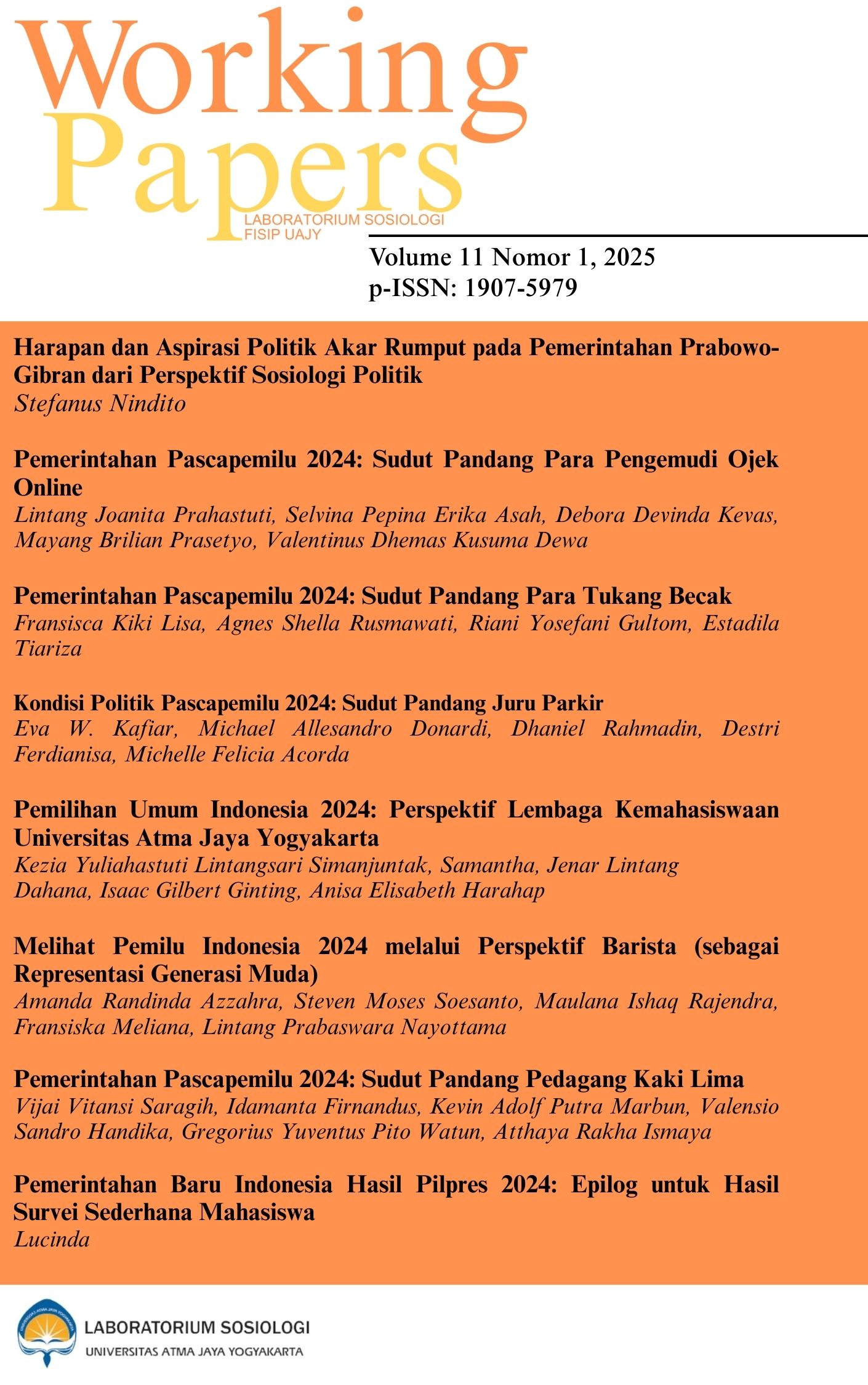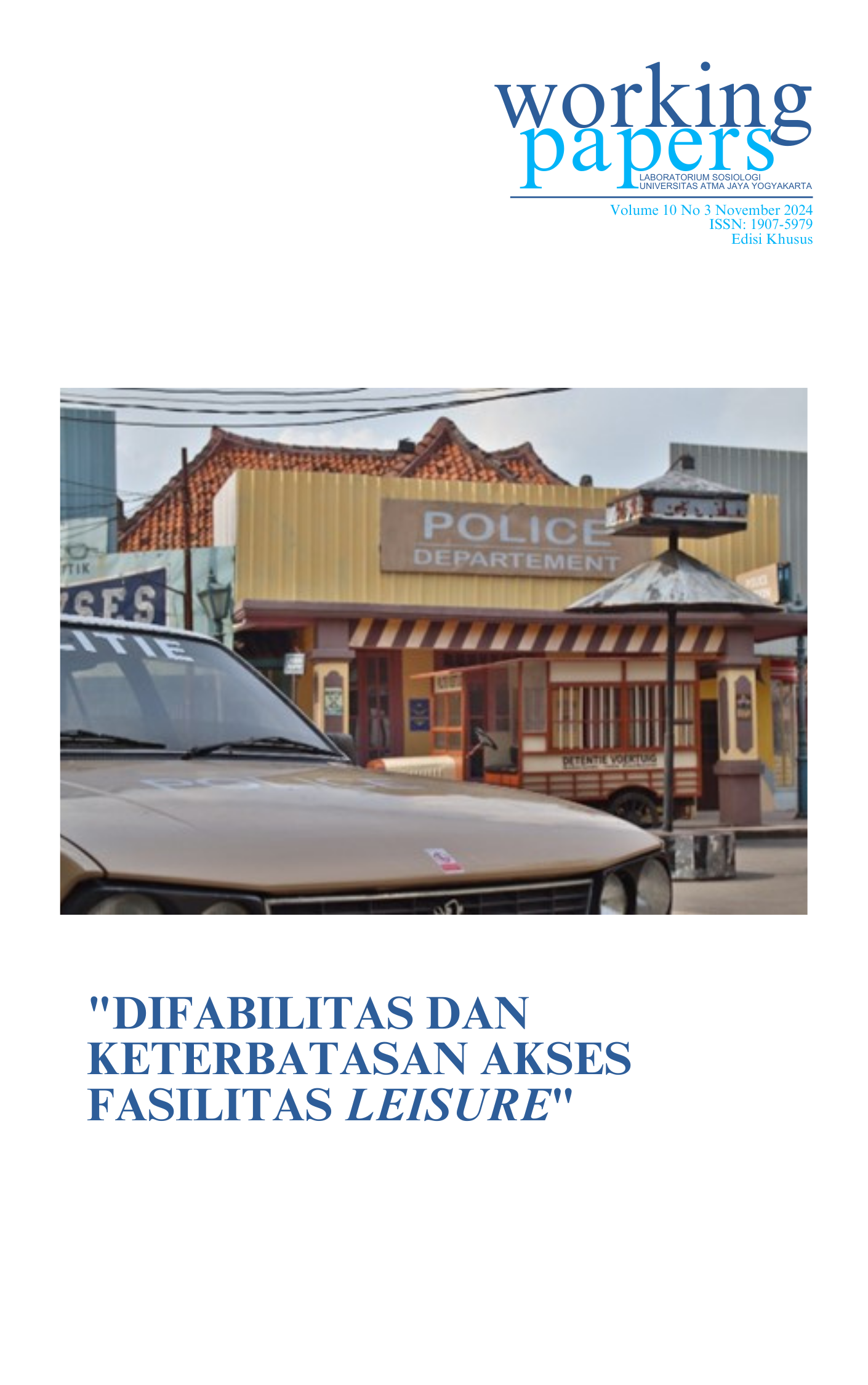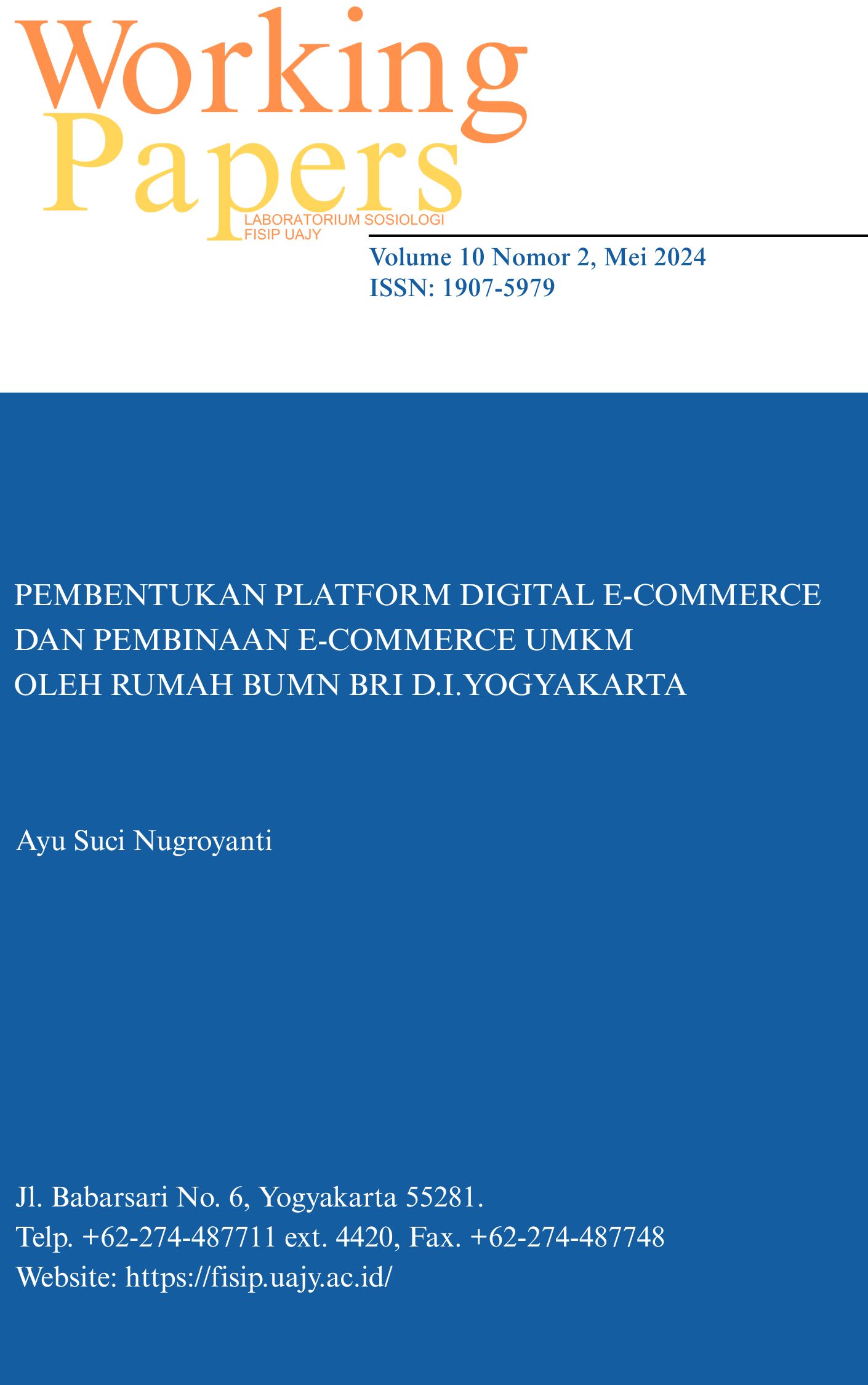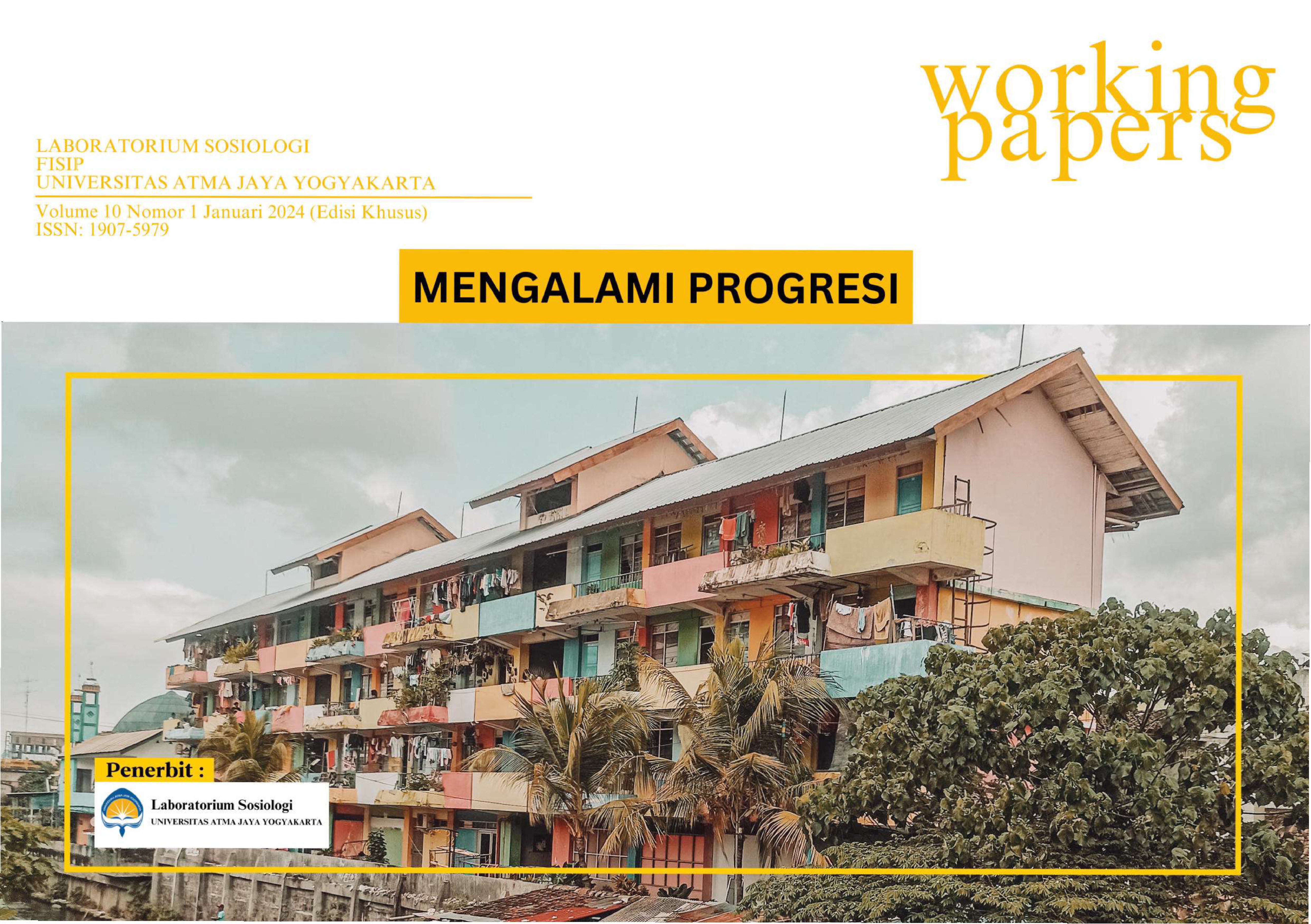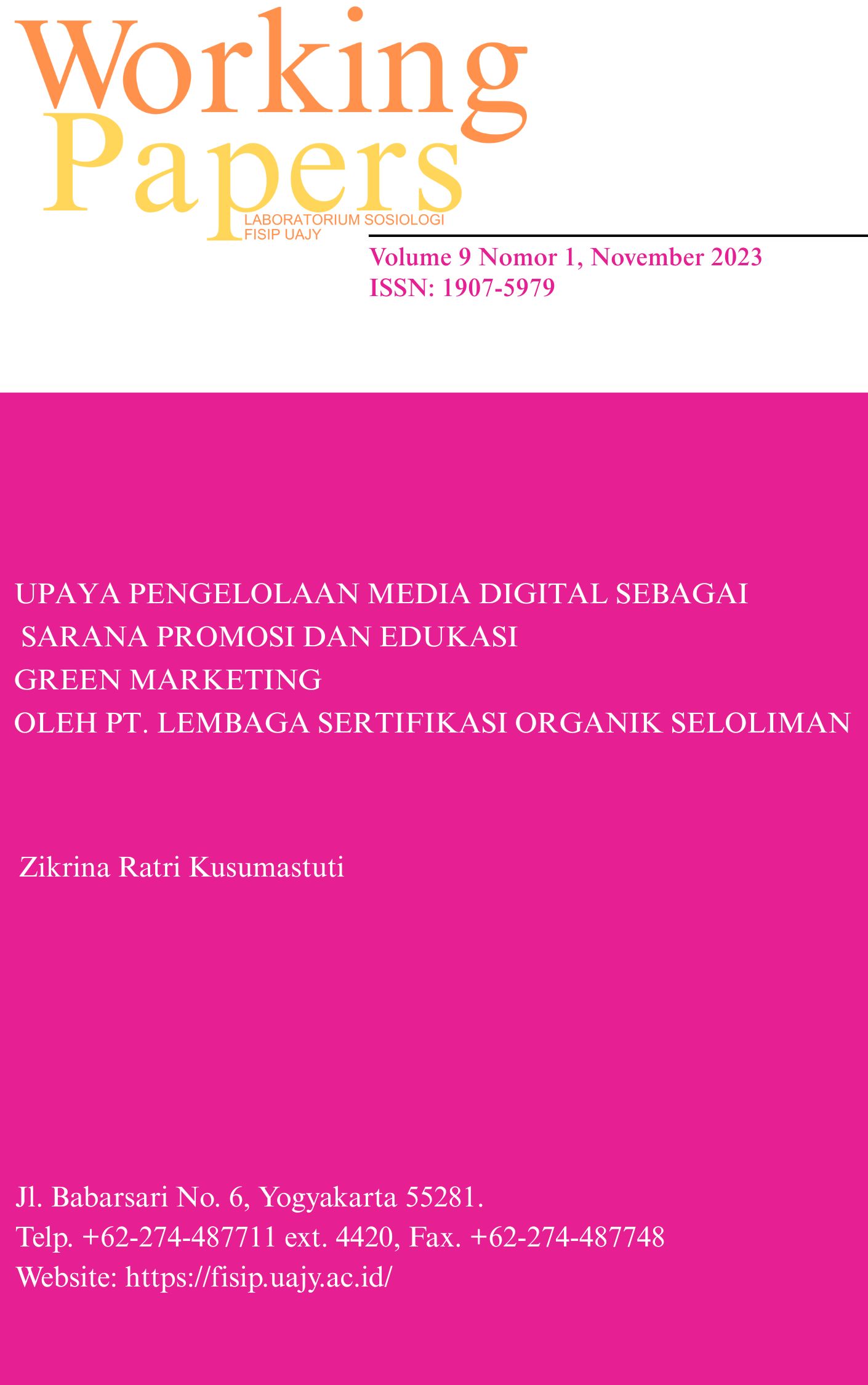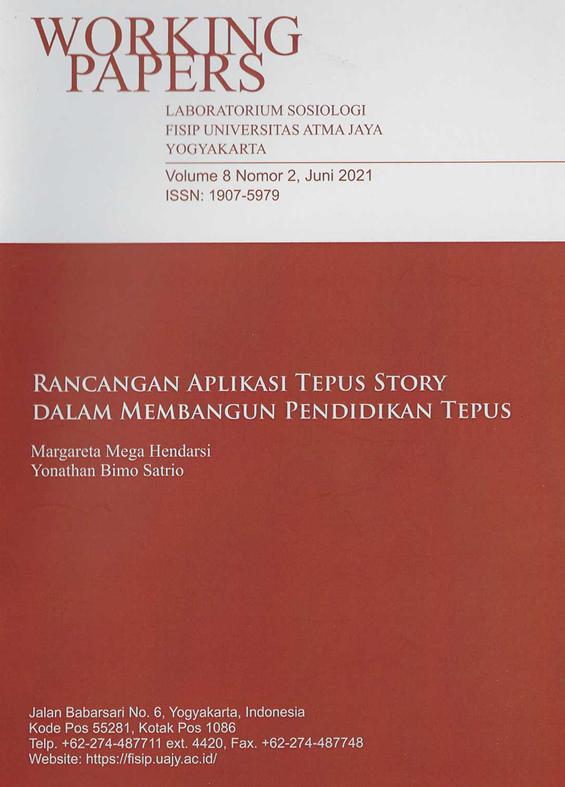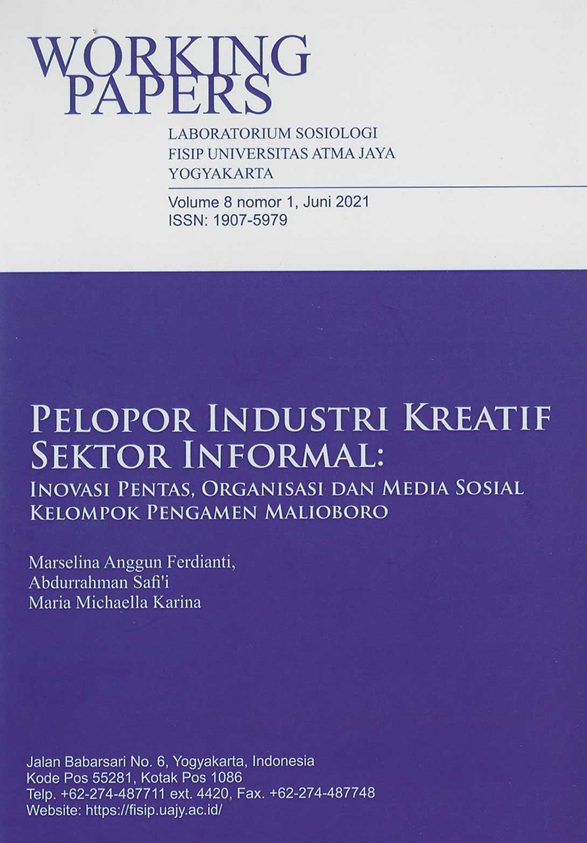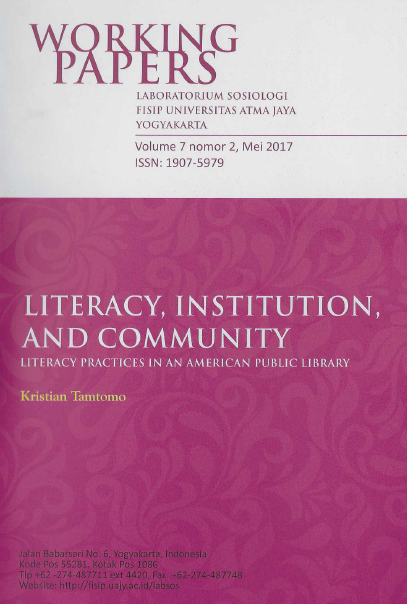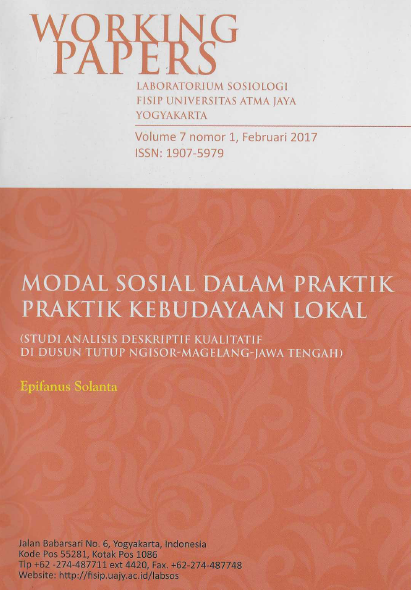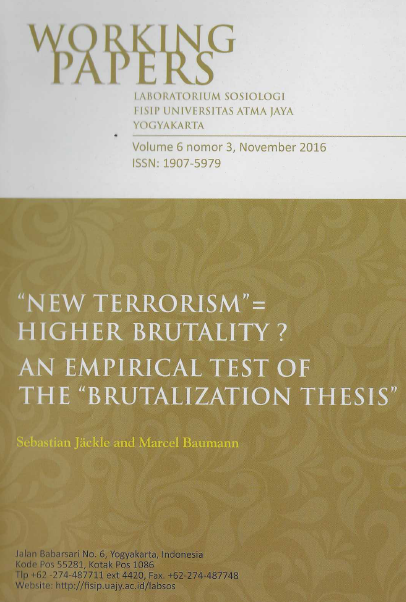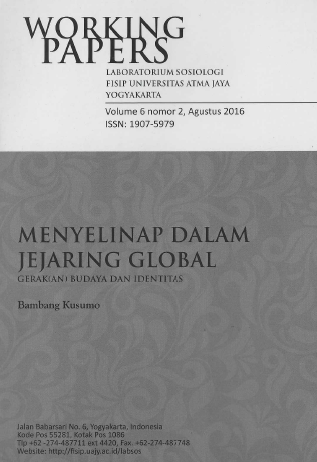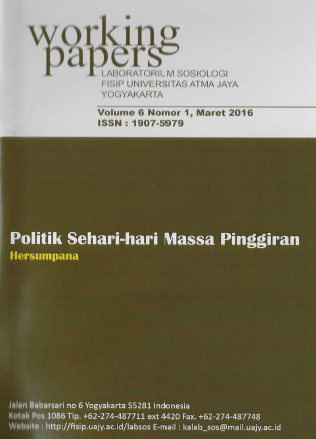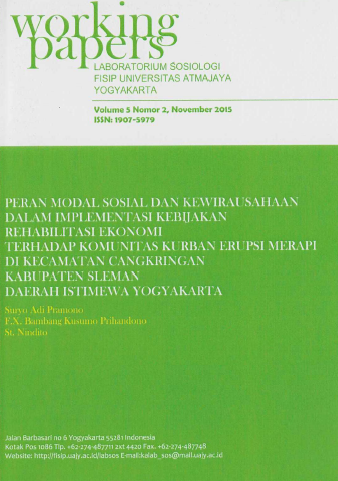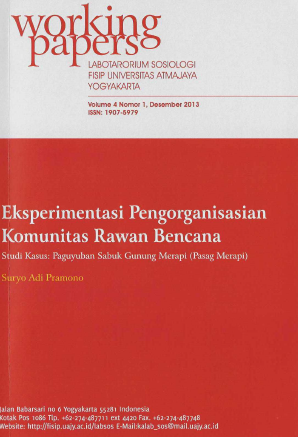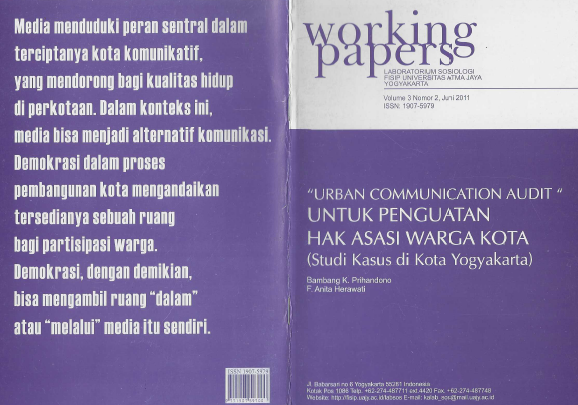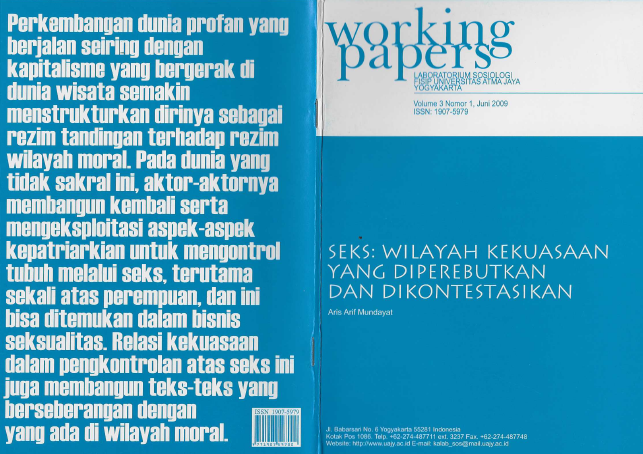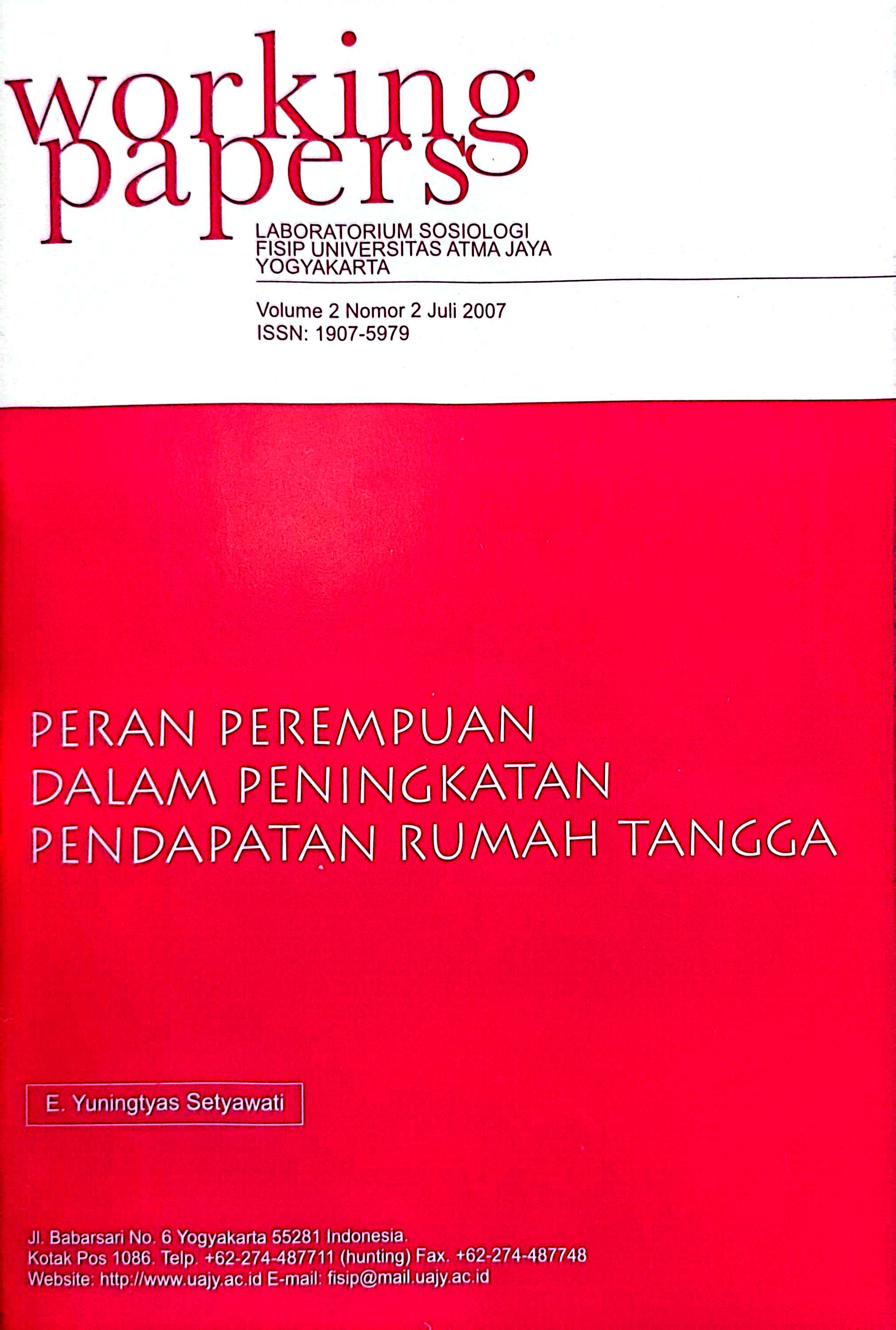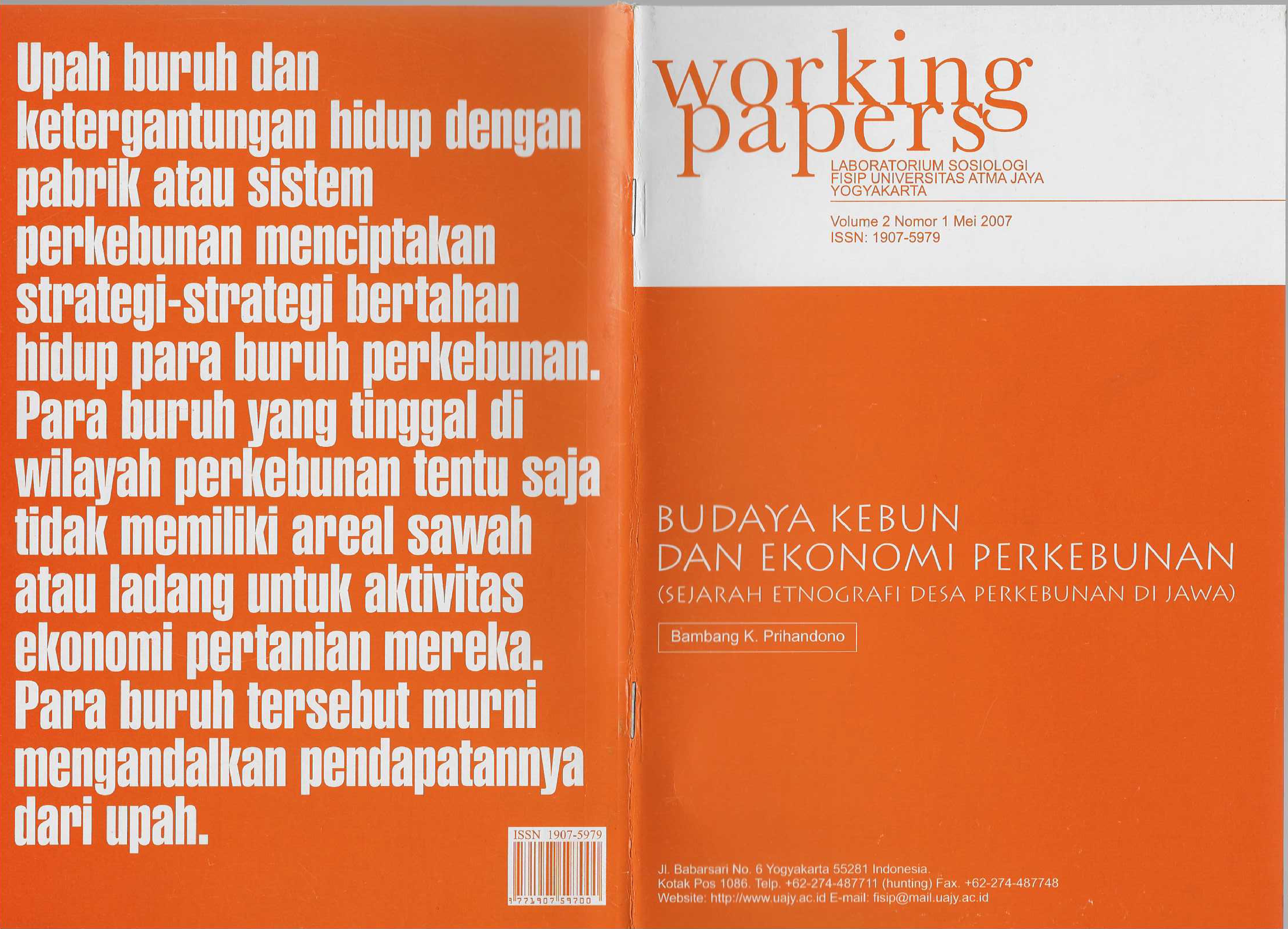Difabilitas dan Keterbatasan Akses Fasilitas Leisure
Vol. 10 No. 3 (2024)
Akses bagi kelompok difabel sangat diperlukan dalam upaya untuk memberikan rekognisiyang layak terhadap kelompok difabel sebagai bagian dari entitas yang turut hidup bersamadalam ruang urban. Lebih lanjut, kelompok difabel juga perlu dikenali sebagai kelompok yangmemerlukan aktivitas waktu senggang (leisure), di mana aktivitas waktu senggang ini jugaturut berkontribusi terhadap pengalaman hidup sosial kelompok difabel. Karena itu,pembahasan mengenai akses bagi kelompok difabel hendaknya juga mencakup akses terhadapfasilitas bagi aktivitas waktu senggang. Dengan pertimbangan ini, Working PapersLaboratorium Sosiologi UAJY edisi ini akan menyajikan hasil observasi sederhana darimahasiswa Sosiologi UAJY pada Studio Alam Gamplong sebagai salah satu lokasi yang seringdijadikan tujuan bagi aktivitas waktu senggang. Diharapkan sajian visual dan tekstual dalamWorking Papers Laboratorium Sosiologi UAJY ini dapat memberikan sedikit kontribusi padaisu mengenai akses terhadap aktivitas waktu senggang bagi kelompok difabel di erakontemporer ini.
Establishment of a Digital E-Commerce Platform and Development of MSME E-Commerce by BRI's State-Owned Enterprises House in Yogyakarta
Vol. 10 No. 2 (2024)
The Rumah BUMN (RB) serves as a hub for fostering and monitoring the development of Micro, Small, and Medium Enterprises (MSMEs) that require improvements in product development, quality, technology utilization, and management. As a center for MSME development, Rumah BUMN implements updates in its MSME development programs to align with the evolving needs of MSMEs.
This paper aims to analyze the establishment of a digital platform and its utilization in the e-commerce development process for MSMEs with diverse backgrounds. The research, titled “The Establishment of a Digital E-commerce Platform and E-commerce Development for MSMEs by Rumah BUMN BRI D.I. Yogyakarta,” is motivated by the challenges faced by MSMEs, which not only concern product development and production processes but also extend to distribution and marketing.
Rumah BUMN acts as an intermediary institution for introducing and socializing the use of digital platforms to MSMEs. This study examines these issues by analyzing the creation of a digital e-commerce platform in the development activities using the SCOT (Social Construction of Technology) theory.
This research employs a qualitative method with data collected through interviews, observations, and secondary data gathering. Informants include representatives from Rumah BUMN and its MSME members.
The findings reveal that the production of digital e-commerce platforms at Rumah BUMN represents a social construction of technology by utilizing three types of e-commerce platforms: general e-commerce, specialized e-commerce, and social media. The digital e-commerce platform supports the development process categorized into MSMEs Go Modern, Go Digital, and Go Online. The digital e-commerce platform in MSME development serves as a solution to overcome product marketing challenges and assists MSMEs in improving their quality to advance toward a digital economy.
Keywords: Digital platform, E-commerce, Development, MSMEs
Mengalami Progresi
Vol. 10 No. 1 (2024)
Kota merupakan ruang dinamis yang tidak dapat terhindarkan dari progresi. Namun demikian, progresi yang terjadi di lingkungan perkotaan tidak serta merta dialami dengan cara yang sama oleh berbagai lapisan masyarakat. Pluralitas pengalaman atas progresi di lingkungan perkotaan inilah yang menjadi sorotan utama dan dikemas dalam bentuk sajian visual pada buku berjudul "Mengalami Progresi" ini. Dengan harapan agar narasi ini masih mendapatkan tempat dan tidak hilang tergerus oleh kemunculan sekat-sekat dalam kehidupan masyarakat.
Efforts to Manage Digital Media as a Means of Green Marketing Promotion and Education by PT. Seloliman Organic Certification Institute
Vol. 9 No. 1 (2023)
The Organic Certification Body (LSO) is an institution established to ensure the quality of organic products. One such body in Indonesia is PT. Lembaga Sertifikasi Organik Seloliman (LeSOS). Verified by the National Accreditation Committee (KAN), PT. LeSOS operates as a national organic certification body across four areas of certification.
With the core principles of ensuring the production process of organic agricultural products, improving farmers’ welfare, and maintaining ecological balance, PT. LeSOS aims to utilize digital media as a tool for promotion and consumer education on environmentally friendly practices.
Through the application of green marketing, this qualitative research seeks to explore in greater depth how PT. LeSOS internally implements Internal Green to manage marketing communication, leverage digital media, and handle content production.
Keywords: Digital media, Green marketing, Organic certification body
Tepus Story Application Design in Building Tepus Education
Vol. 8 No. 2 (2021)
The education conditions in Tepus, Gunung Kidul Regency, Yogyakarta Special Region have shortcomings in terms of facilities. For example, school buildings that do not have roofs, broken floors, and the limited number of student chairs and desks available in classrooms. In addition, there is a shortage of human resources because teachers do not routinely attend school to teach. The curriculum is still lagging behind the curriculum in the city and receives second-hand books from donors. Most students in Tepus do not have the spirit to study, caused by the limited economic conditions of their parents, and some students in Tepus feel that education is unnecessary because they will continue their parents’ work. The parents work as farmers and livestock breeders. Meanwhile, education is very important today not only for the development of intellectual abilities and knowledge but also effective in building the character of children. In relation to Indonesia Emas 2045, education is a medium to prepare the golden generation, not only transferring knowledge but also values in individual character based on three aspects, namely honesty, truth, and justice. Therefore, efforts must be made to improve the education conditions in Tepus. There has already been a movement from a community that provides informal education for elementary school children by offering tutoring services for school lessons and moral education called Tepus Story. This community carries out its activities using the WhatsApp (WA) application as a means to communicate with volunteers, donors, and to get updates on the students in Tepus. Meanwhile, abroad it is more advanced in using applications to organize volunteers, donors, and students. One example is Via Volunteer–South Africa. Therefore, we propose and design Tepus Story using a website-based application. In the use of this application, there are three features. The first feature is the Children feature which provides various game options, homework (PR) options to monitor students’ learning from a distance because Tepus Story activities are only carried out once a week, and a gallery option to share Tepus Story activities. The second is the Donor feature which provides a registration space for Tepus Story donors and a list of donors. The third is the Volunteer feature which provides a registration space for those interested in becoming volunteers and a list of registered volunteers. Finally, there is the Admin feature which contains donation confirmations so that administrators can control incoming donations, a birthday list to know the birthdays of children to be celebrated, and administrators can also input data of students, volunteers, and donors. With this application, the activities of Tepus Story can be managed effectively and efficiently so as to improve the quality of education in Tepus.
Keywords: educational application, informal education, community education
Pelopor Industri Kreatif Sektor Informal: Inovasi Pentas, Organisasi dan Media Sosial Kelompok Pengamen Malioboro
Vol. 8 No. 1 (2021)
The presence of street buskers is often regarded as a social nuisance, as the public frequently feels disturbed by their activities, especially when they move around traffic intersections or along the roadside. However, we aim to show that the group of buskers in the Malioboro area of Yogyakarta possesses distinctive characteristics that make them part of the creative industry within the informal sector. This group of buskers belongs to the millennial generation, with an average age of under 35, and they are active social media users. Their uniqueness lies in the use of various musical instruments that are creatively crafted. Their performances are also different from other buskers because they have scheduled performance times, proper preparation, the use of costumes, and collaborations with traditional dancers. The group delivers performances featuring popular songs arranged in diverse variations without abandoning local cultural elements. They also utilize social media platforms such as Instagram and YouTube to promote culture and their business by offering their services to perform at various events. These aspects make the Malioboro buskers appear more professional and help change the public stigma surrounding street buskers. The differences and uniqueness demonstrated by the buskers in the Malioboro area show that this occupation represents a creative industry sector based on art and culture. This sector collaborates with the Yogyakarta Tourism Office, as there are permits and regulations that must be agreed upon between the buskers and the Tourism Office. The various forms of creativity expressed by the Malioboro busker group hold potential for the creative industry, which is expected to empower the millennial generation to realize a creative, productive, and high-quality golden generation by 2045.
Keywords: Busker Group Innovation, Creative Industry Organization, Social Media
Literacy, Institution, and Community
Vol. 7 No. 2 (2017)
In understanding literacy as a social practice, it is important to explore the social contexts surrounding the enactment and sustainment of literacy activities. One important aspect of the social context of literacy is what Long (1993) calls as the "infrastructure of literacy." This covers various institutions and actors that support or act as "sponsors of literacy" (Brandt 1999) at the group or community level. In the context of American society, in addition to schools, public libraries have historically taken the mandate of being a key institution that acts as an infrastructure and sponsor of literacy activities within the community (Harris 1975). As an institution that sponsors literacy, the library has a certain vision and mission about the kinds of literacy activities it would like to promote and the kinds of social effects these literacy activities should achieve. Nonetheless, as a space and context for literacy practices, the library also becomes a site for various types of literacy activities, each with their own social or personal purposes.
Keywords: libraries, institutions, literacy practices
Social Capital in Local Cultural Practices (Descriptive Analysis Study in the Hamlet of Tutup Ngisor-Magelang-Central Java
Vol. 7 No. 1 (2017)
This research aims to describe and analyze: (1) the forms of local cultural practices in Dusun Tutup Ngisor; (2) art as social capital and social capital as art within local cultural practices; and (3) the accumulation of social capital based on network structures through local cultural practices centered on performing arts.
In conducting this study, the author employed a qualitative descriptive research method. Primary data were collected through interviews with several key actors in Dusun Tutup Ngisor. In addition to interviews, Focus Group Discussions (FGDs) were carried out with local residents, alongside active participation in community activities. Secondary data were obtained through literature reviews in libraries and online sources. The collected data were then analyzed using data categorization and a triangulation process. Furthermore, in mapping the social network, the author applied sociometric analysis methods.
The findings of this research reveal that: (1) the forms of local cultural practices in Dusun Tutup Ngisor include mandatory performances held four times a year, offerings (sesaji), the Dewi Sri performance, and the Friday night gamelan show; (2) these local cultural practices develop due to the strength of social capital and network structures involving government institutions, churches, schools, media, and art communities; and (3) the forms of social capital identified include participation, group cooperation, social norms, trust, and reciprocity.
Keywords: Art, Local Culture, Network Structure, Social Capital
"New Terrorism" = Higher Brutality? An Empirical Test of The "Brutalization Thesis"
Vol. 6 No. 3 (2016)
This article focuses on the so-called "brutalization" of terrorism. The brutalization thesis as part of the larger theoretical concept of "new terrorism" argues that "new terrorism" is more brutal than "old terrorism." Many scholars claim that the 9/11 attacks mark the beginning of a new era of terrorism that has lifted international as well as domestic terrorism to a new level of violent brutality. Others argue that this process had already started in the early 1990s. After discussing possible ways to operationalize a brutalization of terrorism, for example focusing on suicide bombings or terrorist attacks against soft targets, this article tests the empirical credibility of the brutalization thesis regarding both potential starting points. Data from the Global Terrorism Database (GTD) shows that only three out of nine indicators increased signi fi cantly during the 1990s, partially backing the idea of a general brutalization, whereas increasing numbers of suicide attacks and beheadings after 9/11 support the notion of a qualitative change in terrorism and its brutality connected with the idea of maximizing media and public attention. Yet, these developments are regionally limited and the brutality of this "new terrorism" exceeds the levels known from the zenith of "old terrorism" in the 1970s and 1980s in only a few cases.
Keywords: Beheadings; brutalization; Global Terrorism Database (GTD); new terrorism; soft targets, suicide attacks
Sneaking into the Global Network: Cultural Movements and Identity
Vol. 6 No. 2 (2016)
Everyday Politics of the Marginal Masses
Vol. 6 No. 1 (2016)
Urban development presents an opportunity for improving welfare. However, for those who are unable to seize this opportunity—both migrants and local residents—it can lead to their becoming marginalized groups. These peripheral groups are unable to fully integrate into the modern urban system. Nevertheless, such marginalized communities develop their own strategies to survive. The Bong Suwung community, for example, creates its own economic and political tactics to face urban modernity, which, in the eyes of the authorities, often labels them as a “disturbance” or a negative image of the city. Despite this, there exists an invisible relationship of power between the authorities and the communities deemed illegal. The phenomenon of beking (protection) represents a strategy that emerges in the lives of groups like Bong Suwung, exemplified by the involvement of certain military personnel with illegal communities—a situation described by Edward Aspinall and Gerry Van Klinken as “entrenched illegality.” This section further discusses the everyday political strategies of the Bong Suwung community and the transformation of the community amid the urban development of Yogyakarta in relation to state power.
Sex: A Contested and Contested Territory of Power
Vol. 3 No. 1 (2009)
Based on field data in the form of case studies of two women from Sukabumi (West Java) and Sanur (Bali), this paper discusses issues of sexuality and the authority over women’s bodies in the social sphere. In this context, the female body is not merely a dominated entity, but rather a realm of sexuality whose meaning is contested and negotiated within the social world inhabited by both women and men.
Peran Perempuan Dalam Peningkatan Pendapatan Rumah Tangga
Vol. 2 No. 2 (2007)
Mata pencaharian nelayan dapat dijadikan tumpuan ekonomi bagi rumah tangga nelayan di samping pekerjaan di sektor pertanian. Meskipun pendapatan yang dihasilkan nelayan di sekitar Pantai Ngrenehan saat ini belumlah cukup menggembirakan. Namun demikian pekerjaan di sektor perikanan mampu menjadi alternatif lain dari sektor pertanian yang lebih menguntungkan. Untuk menutupi kebutuhan rumah tangga, maka istri nelayan biasanya turut serta dalam aktivitas perikanan. Aktivitas yang dilakukan oleh istri nelayan adalah berjualan ikan hasil tangkapan dan membuka warung-warung makan di sekitar pantai. Pendapatan istri nelayan biasanya jauh lebih tinggi daripada suami mereka, saat sepi saja rata-rata pendapatan istri nelayan Rp. 20.000,- hingga Rp. 30.000,- perhari, namun ketika hari libur seperti Sabtu dan Minggu serta hari libur nasional pendapatan mereka jauh lebih banyak. Sementara suami mereka setiap kali selesai melaut hanya memperoleh upah pendapatan rata-rata Rp. 50.000,-, apalagi kalau hasil tangkapan ikannya hanya sedikit sekali mereka tentunya akan lebih merugi. Besarnya kontribusi peran publik perempuan tidaklah mengurangi peran domestiknya, curahan waktu perempuan di sektor domestik dan publik menunjukkan rata-rata: perempuan mencurahkan waktu 13-15 jam sehari untuk melakukan pekerjaan domestik dan publik sekaligus. Sementara curahan waktu laki-laki sebanyak ± 8-10 jam sehari, bila diasumsikan laki-laki hanya bekerja di sektor publik dan tidak terlibat dalam pekerjaan domestik. Dengan demikian peran gender dalam rumah tangga masih nampak orientasi pada bias gender, sehingga perlu adanya penyadaran gender agar dapat terwujud kemitrasejajaran antara laki-laki dan perempuan dalam rumah tangga. Hal ini berguna untuk mengembangkan potensi sumberdaya yang dimiliki baik laki-laki maupun perempuan.
Kata kunci: peran gender, kemitrasejajaran laki-laki perempuan, dan ekonomi rumah tangga
Budaya Kebun dan Ekonomi Perkebunan (Sejarah Etnografi Desa Perkebunan Di Jawa)
Vol. 2 No. 1 (2007)
Kolonialisme merupakan faktor penting dalam pembentukan sistem perkebunan di Indonesia sebagai sistem sosial-ekonomi yang baru. Ekonomi politik pertanian kolonial memperkenalkan sistem baru di wilayah-wilayah lokal, mengubah sistem ekonomi dari subsistensi pedesaan menjadi pertanian berorientasi ekspor. Dalam kasus wilayah Kendeng Lembu, khususnya pada masa pascakolonial, fluktuasi dalam perkembangan perkebunan berkaitan dengan proyek dekolonisasi di bidang politik dan ekonomi. Meskipun telah terjadi proses dekolonisasi, sistem dan struktur sosial di perkebunan Kendeng Lembu tampaknya merupakan tiruan dari warisan sistem perkebunan kolonial.

